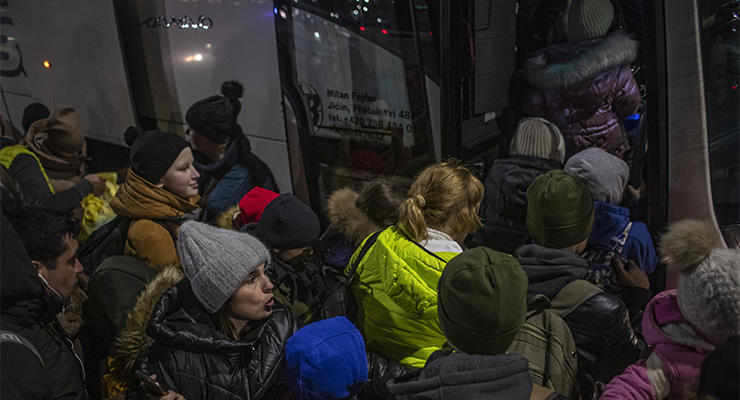
Those in the battle-sieged Ukrainian cities of Kyiv, Kharkiv and Luhansk who haven’t fled are seeking refuge from bombs and missiles in crowded underground train stations, basements and bunkers.
Refugees are rushing to the neighbouring countries; thousands of women and children are attempting to catch trains out of Ukraine. More than 500,000 Ukrainians have left the country since Russia invaded five days ago.
Ukrainians also face an ongoing risk: just 36% of the population is fully vaccinated against COVID. Rates of vaccine-preventable diseases are already high, with just 19% of the population vaccinated for diphtheria, tetanus and pertussis, and 42% for measles, mumps and rubella.
As more and more of Ukraine’s population become displaced, rates of communicable diseases are likely to skyrocket — worrying for Ukrainians and the countries hosting them.
Infectious diseases an ongoing concern
Ukraine is experiencing a winter surge of COVID; there has been a record high 253,000 new daily cases in the second week of February. More than 112,000 COVID-related deaths have been recorded since the pandemic started.
At the weekend the World Health Organization warned Ukraine was running dangerously low on oxygen supplies as transport systems are disrupted.
But COVID isn’t the only disease Ukraine is battling: it lags behind its neighbours in routine childhood vaccinations. Fewer than 80% of kids aged 12 to 59 months have received three doses of the combined diphtheria, tetanus toxoid and pertussis vaccine.
In October last year it experienced an outbreak of polio, and launched a national polio control plan to boost childhood immunisation rates. Between 2017 and 2019, 57,000 people were infected with measles.
As at 2019, life expectancy in Ukraine was 71.8 (though there’s a large gap between the genders: men live on average to 66 and women to 76). Across the European Union, life expectancy is 81.3. Infant mortality is double in Ukraine than in the EU at 7.5 per 1000 live births.
War and infectious diseases go hand in hand
Infectious diseases are a deadly side effect of war for three reasons, says associate professor of infectious diseases, immunisation and emergencies at Sydney University Meru Sheel.
First, displaced populations have a greater risk of contracting infectious diseases in general due to close contact and overcrowding from people travelling and living together: “I think measles, chickenpox and hepatitis will pose a greater risk in Ukraine.”
Second, sanitation is a concern with waterborne diseases often circulating among refugee camps. With sanitation and water supply systems often disrupted, diseases like cholera, dysentery, meningitis and typhus spread. The crude mortality rate in displacement settlements can be 60 times higher than in baseline rates. Across three weeks in 1994, more than 12,000 Rwandan refugees in the Democratic Republic of Congo died from cholera and dysentery.
But Sheel says the cold eastern European weather would be likely to stop some of these diseases from spreading.
Third, war disrupts vaccination programs. In Sierra Leone the number of children aged under three who were fully vaccinated dropped from 75% at the start of the war to 50% in 2001 causing infant mortality to spike from 70 per 1000 live births in 1987 to 280 by 2005.
What could this mean for Europe?
The United Nations has estimated 1 to 5 million refugees will flee Ukraine to neighbouring countries — Poland, Hungary, Slovakia, Romania and non-EU member Moldova. Poland, Slovakia and Hungary have high childhood immunisation rates although Romania and Moldova lag.
To prevent outbreaks of diseases such as measles, vaccination coverage has to be above 95% for one of two doses, Sheel says — meaning ensuring vaccination programs continued to be scheduled was key to protect eastern Europe.
“We have to make sure that displaced populations are not excluded from vaccination systems, and are supported so they can be given a vaccine upon entry,” she said. “This is one of the best ways to protect the migrant population but also the host community.”








Makes you wonder whats happening in the Russian tanks. Russia already had low vax rates and soldiers generally think they are bullet proof and machismo personified. In a tank you have several men, unmasked, in a confined space. Recipe for covid. Anyone know the covid status of the invasion troops?
Does anyone know why Ukraine lags not only in Covid vaccination, but in childhood vaccinations too?